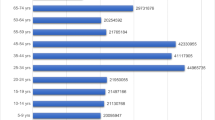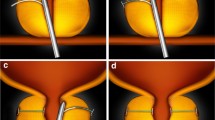Abstract
Purpose of Review
Freedom from medication is a common goal for patients undergoing surgical treatment of benign prostatic hyperplasia (BPH)/lower urinary tract symptoms (LUTS). Knowing medication discontinuation rates following various forms of transurethral prostatectomy may aid patient counseling and assessing the comparative effectiveness of different approaches. This review examined discontinuation rates of BPH/LUTS medications following transurethral prostatectomy.
Recent Findings
Rates of BPH/LUTS medication use after transurethral resection of the prostate varied from 15% to 55%, and discontinuation rates were 54–95% across medications and follow-up periods. For laser prostatectomy, approximately 18% of patients continued medications postoperatively and discontinuation rates ranged from 53% to 75%. Minimal data on holmium laser enucleation existed. For reference, medication discontinuation rates after transurethral needle ablation or microwave therapy were only 15–28%.
Summary
No recommendations or best practices inform the use of medical therapy following BPH surgery. Rates of BPH/LUTS medication use following transurethral prostatectomy are considerable.
Similar content being viewed by others
References
Papers of particular interest, published recently, have been highlighted as: • Of importance •• Of major importance
Feinstein L, Matlaga B. Urologic diseases in America. [Internet]. Washington, DC; 2018. Available from: https://www.niddk.nih.gov/about-niddk/strategic-plans-reports/urologic-diseases-in-america. Accessed 12 Feb 2020.
Hashim H, Abrams P. Transurethral resection of the prostate for benign prostatic obstruction: Will it remain the gold standard? Eur Urol Elsevier. 2015;67:1097–8.
Foster HE, Dahm P, Kohler TS, Lerner LB, Parsons JK, Wilt TJ, et al. Surgical management of lower urinary tract symptoms attributed to benign prostatic hyperplasia: AUA Guideline Amendment 2019. J Urol [Internet]. 2019;202(3):592–8 [cited 2020 Feb 21] Available from: http://www.ncbi.nlm.nih.gov/pubmed/31059668.
•• Sabharwal NC, Shoskes DA, Dielubanza EJ, Ulchaker JC, Fareed K, Gill BC. Comparative Effectiveness of transurethral prostate procedures at enabling urologic medication discontinuation: a retrospective analysis. Urol Int. 2019;134:192–8 [cited 2020 Feb 8] Available from: http://www.ncbi.nlm.nih.gov/pubmed/31542460. This retrospective review of 5150 patients at a large regional health system examined BPH/LUTS medication discontinuation rates across multiple procedures including TURP, LP, TUNA/TUMT, and simple prostatectomy. At greater than 12-month follow-up, 62.0% of TURP patients had discontinued all medications compared with 52.9% of LP patients and 27.7% of TUMT/TUNA patients.
•• Campbell J, Reid J, Ordon M, Welk B. The utilization of benign prostatic hyperplasia and bladder-related medications after a transurethral prostatectomy. Urol Int. 2019;130:126–31 [cited 2020 Feb 8] Available from: http://www.ncbi.nlm.nih.gov/pubmed/31129193. Nearly 60,000 patients were included in this database study that examined BPH/LUTS medication use prior to TURP, after a 90-day washout period post-operatively and at 10-year follow-up. Rates of AB and 5ARI use dropped following TURP, while rates of AC/B3A actually increased at both follow-up time periods.
Roehrborn CG, Nuckolls JG, Wei JT, Steers W. The benign prostatic hyperplasia registry and patient survey: study design, methods and patient baseline characteristics. BJU Int [Internet]. 2007;100(4):813–9 [cited 2020 Feb 8] Available from: http://www.ncbi.nlm.nih.gov/pubmed/17822462.
Chughtai B, Simma-Chiang V, Kaplan SA. Evaluation and management of post-transurethral resection of the prostate lower urinary tract symptoms. Curr Urol Rep [Internet]. 2014;15(9):434 [cited 2020 Feb 8] Available from: http://www.ncbi.nlm.nih.gov/pubmed/25037906.
Kim SJ, Al Hussein Alawamlh O, Chughtai B, Lee RK. Lower urinary tract symptoms following transurethral resection of prostate. Curr Urol Rep. 2018;19(10).
Tehranchi A, Rezaei Y, Shojaee R. Tolterodine to relieve urinary symptoms following transurethral resection of the prostate: a double-blind placebo-controlled randomized clinical trial. Korean J Urol [Internet]. 2014;55(4):260–4 [cited 2020 Feb 8] Available from: http://www.ncbi.nlm.nih.gov/pubmed/24741415.
Shin YS, Zhang LT, You JH, Choi IS, Zhao C, Park JK. Efficacy and safety of tamsulosin hydrochloride 0.2 mg and combination of tamsulosin hydrochloride 0.2 mg plus solifenacin succinate 5 mg after transurethral resection of the prostate: a prospective, randomized controlled trial. Clin Interv Aging. 2016;11:1301–7.
Qian X, Yu G, Qian Y, Xu D, Liu H, Kong X, et al. Efficacy of 5 α-reductase inhibitors for patients with large benign prostatic hyperplasia (>80 mL) after transurethral resection of the prostate. Aging Male [Internet]. 2015;18(4):238–43 [cited 2020 Feb 8] Available from: http://www.ncbi.nlm.nih.gov/pubmed/26225794.
DeWitt-Foy ME, Gill BC, Ulchaker JC. Cost comparison of benign prostatic hyperplasia treatment options. Curr Urol Rep. 2019;20(8):1–7.
Ulchaker JC, Martinson MS. Cost-effectiveness analysis of six therapies for the treatment of lower urinary tract symptoms due to benign prostatic hyperplasia. Clin Outcomes Res. 2018;10:29–43.
Ahyai SA, Lehrich K, Kuntz RM. Holmium Laser enucleation versus transurethral resection of the prostate: 3-year follow-up results of a randomized clinical trial. Eur Urol [Internet]. 2007;52(5):1456–64 [cited 2020 Mar 2] Available from: http://www.ncbi.nlm.nih.gov/pubmed/17499427.
Thangasamy IA, Chalasani V, Bachmann A, Woo HH. Photoselective vaporisation of the prostate using 80-W and 120-W laser versus transurethral resection of the prostate for benign prostatic hyperplasia: A systematic review with meta-analysis from 2002 to 2012. Eur Urol Elsevier. 2012;62:315–23.
Cornu JN, Ahyai S, Bachmann A, De La Rosette J, Gilling P, Gratzke C, et al. A systematic review and meta-analysis of functional outcomes and complications following transurethral procedures for lower urinary tract symptoms resulting from benign prostatic obstruction: an update. Eur Urol Elsevier. 2015;67:1066–96.
Geavlete B, Stanescu F, Iacoboaie C, Geavlete P. Bipolar plasma enucleation of the prostate vs open prostatectomy in large benign prostatic hyperplasia cases—a medium term, prospective, randomized comparison. BJU Int. 2013;111(5):793–803.
Rieken M, Bachmann A. Update on Greenlight laser vaporization (PVP) 2014. World J Urol Springer Verlag. 2015;33:531–7.
Thomas JA, Tubaro A, Barber N, D’Ancona F, Muir G, Witzsch U, et al. A multicenter randomized noninferiority trial comparing GreenLight-XPS laser vaporization of the prostate and transurethral resection of the prostate for the treatment of benign prostatic obstruction: two-yr outcomes of the GOLIATH Study. Eur Urol. 2016;69(1):94–102.
• Han HH, Ko WJ, Yoo TK, Oh TH, Kim DY, Kwon DD, et al. Factors associated with continuing medical therapy after transurethral resection of prostate. Urology. 2014;84(3):675–80 Of 72 patients who underwent TURP, retrospective review determined predictors for requiring BPH/LUTS medications for greater than 3-month post-operatively. Significant predictors included diabetes, history of cerebrovascular accident, prior BPH/LUTS medication use, and previous AC/B3A use.
• Strope SA, Vetter J, Elliott S, Andriole GL, Olsen MA. Use of medical therapy and success of laser surgery and transurethral resection of the prostate for benign prostatic hyperplasia. Urology. 2015;86(6):1115–22 This study assessed the impact of TURP (3096 patients) versus LP (3334) on post-operative rates of BPH medication use, as well as predictors for repeat intervention (surgical or medical). Pre-operative use of AC/B3A was the most significant predictor of medication use 4 months after surgery.
• Zhang JH, Gill BA, Wilkins L, Ramkumar RR, Shoskes DA. Systemic comorbidity burden using the actions phenotype predicts urologic medication discontinuation following transurethral resection of the prostate. Urol Int. 2019;127:91–6 [cited 2020 Feb 8] Available from: http://www.ncbi.nlm.nih.gov/pubmed/30822484. Comorbidities from the ACTIONS phenotype (with domains that include Anxiety, Cardiovascular, Testosterone, Insulin/diabetes, Obesity, Neurologic, Sleep apnea) were examined in 319 men who underwent TURP. Decreased comorbidity burden, as well as specific comorbidities, were associated with decreased risk for requiring BPH medication post-operatively.
Shoskes DA, Vij SC, Shoskes A, Nyame Y, Gao T. Development of a clinically relevant men’s health phenotype and correlation of systemic and urologic conditions. Urol Int. 2018;114:77–82 [cited 2020 mar 22] Available from: http://www.ncbi.nlm.nih.gov/pubmed/29360485.
• Woo MJ, Ha YS, Lee JN, Kim BS, Kim HT, Kim TH, et al. Comparison of surgical outcomes between holmium laser enucleation and transurethral resection of the prostate in patients with detrusor underactivity. Int Neurourol J. 2017;21(1):46–52 Patients who underwent HoLEP (N=24) were compared with those who underwent TURP (N = 32), and results showed that HoLEP patients were more likely to discontinue their ABs or ACs. This study is important because it is the only one that investigated BPH medication discontinuation rates following HoLEP but was limited in generalizability as all patients included in the study had detrusor underactivity.
Anderson BB, Heiman J, Large T, Lingeman J, Krambeck A. Trends and perioperative outcomes across major benign prostatic hyperplasia procedures from the ACS-NSQIP 2011–2015. J Endourol [Internet]. 2019;33(1):62–8 [cited 2020 Feb 21] Available from: https://www.liebertpub.com/doi/10.1089/end.2018.0266.
Gilling PJ, Aho TF, Frampton CM, King CJ, Fraundorfer MR. Holmium Laser enucleation of the prostate: results at 6 years. Eur Urol [Internet]. 2008;53(4):744–9 [cited 2020 mar 2] Available from: http://www.ncbi.nlm.nih.gov/pubmed/17475395.
Kuntz RM, Lehrich K, Ahyai SA. Holmium laser enucleation of the prostate versus open prostatectomy for prostates greater than 100 grams: 5-year follow-up results of a randomised clinical trial. Eur Urol [Internet]. 2008;53(1):160–8 [cited 2020 Mar 2] Available from: http://www.ncbi.nlm.nih.gov/pubmed/17869409.
Rosario DJ, Phillips JT, Chapple CR. Durability and cost-effectiveness of transurethral needle ablation of the prostate as an alternative to transurethral resection of the prostate when α-adrenergic antagonist therapy fails. J Urol. 2007;177(3):1047–51.
Fantus R, Chang C, Helfand B. Clinical practice patterns for lower urinary tract symptoms by urologists and non-urologists in the United States: an analysis of the national ambulatory medical care survey. J Urol. 2019;201(Supplement 4):e375.
Lyseng-Williamson KA, Jarvis B, Wagstaff AJ. Tamsulosin: an update of its role in the management of lower urinary tract symptoms [Internet]. In: Drugs, vol. 62: Adis International Ltd; 2002. p. 135–67. [cited 2020 Mar 2] Available from: http://www.ncbi.nlm.nih.gov/pubmed/11790159.
Author information
Authors and Affiliations
Corresponding author
Ethics declarations
Conflict of Interest
The authors have no pertinent conflicts of interest related to the subject matter presented in this review. While Dr. Gill has served as a consultant for Boston Scientific, it is for unrelated clinical topics and technologies.
Human and Animal Rights
The research presented in this article is comprised of a literature review and does not involve the use of live human or animal subjects. However, any studies cited that were performed by the authors and involved human or animal subjects were performed in accordance with all applicable ethical standards, including the Helsinki declaration and its amendments, institutional/national research committee standards, and international/national/institutional guidelines.
Additional information
Publisher’s Note
Springer Nature remains neutral with regard to jurisdictional claims in published maps and institutional affiliations.
This article is part of the Topical Collection on Benign Prostatic Hyperplasia
Rights and permissions
About this article
Cite this article
Campbell, R.A., Gill, B.C. Medication Discontinuation Following Transurethral Prostatectomy: an Unrecognized Effectiveness Measure?. Curr Urol Rep 21, 61 (2020). https://doi.org/10.1007/s11934-020-01015-9
Accepted:
Published:
DOI: https://doi.org/10.1007/s11934-020-01015-9




